What Is Email Encryption?
Encryption is the process of turning plaintext information into meaningless secret code, known as ciphertext. To decode ciphertext and transform it back into its plaintext form, the correct decryption key must be provided.
In the context of email communication, Gmail encryption is used for two different purposes:
- In transit encryption: This type of email encryption protects messages as they travel between mail servers. Its main purpose is to prevent the so-called man-in-the-middle attacks, in which the attacker positions himself or herself between two parties communicating with each other.
- At rest encryption: Messages can be compromised not only when traveling from server to server but also when being stored on a hard drive, and that’s where at rest encryption comes in, making it impossible for a hacker to break into Google’s data center, steal a bunch of hard drives, and read the messages stored on them.
Obviously, you want to encrypt your messages both in transit and at rest to keep them as secure as possible.
Is Gmail Encrypted?
Yes, Gmail encrypts all messages by default—both in transit and at rest to protect its users from hackers.
For in-transit encryption, it uses something called TLS, or Transport Layer Security. TLS is a cryptographic protocol that’s used not only by mail services like Gmail but also by various instant messaging and web applications.
Thanks to TLS, it’s impossible for an attacker to intercept a message and read it, such as by setting up a malicious Wi-Fi hotspot in a public area. The attack would see only meaningless secret code, and it would be impossible for them to decipher it.
As far as at-rest encryption goes, Gmail uses the Advanced Encryption Standard (AES) algorithm to encrypt all data stored on its servers. The same algorithm is also approved by the U.S. National Security Agency (NSA) for top-secret information, so you can rest assured knowing that your messages are protected well.
Thanks to TLS and AES being enabled by default, you don’t need to learn how to encrypt an email in Gmail to enjoy a solid level of protection, but that doesn’t mean you can’t go beyond it.
How to Enhance Gmail Message Security?
Many users are searching for guides on how to encrypt email Gmail offers, to enhance their online security. There are other ways how to send an encrypted email in Gmail, but they’re not enabled by default.
The users of Enterprise, Education Fundamentals, Education Standard, Teaching and Learning Upgrade, and Education Plus editions of Gmail can enable S/MIME for message encryption.
This advanced encryption technology is based on asymmetric cryptography, using a key pair consisting of one private key and one public key to ensure that nobody besides the intended recipient can read your messages. If you're sending sensitive information frequently, it's advisable to use the Gmail encrypt email function to protect your data.
You can enable hosted S/MIME from the Google Admin console:
- Log in to the Google Admin console.
- Navigate to Menu → Apps → Google Workspace → Gmail → User settings.
- On the left, under Organizations, select the domain or organization you want to configure.
- Scroll to the S/MIME setting and check the Enable S/MIME encryption for sending and receiving emails box.
- Click Save.
Besides S/MIME, there’s also Gmail’s confidential mode. This special mode protects your privacy by making it impossible for recipients to forward, copy, print, and download your messages from Gmail.
To send a confidential message via a web browser:
- Log in to your Gmail account.
- Click Compose.
- Click Toggle confidential mode in the bottom right of the window.
- Set an expiration date and passcode.
- Click Save.



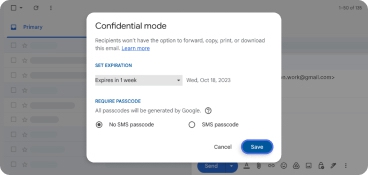
To secure your Gmail emails on Android and iOS:
- Open the Gmail app.
- Tap Compose (pencil icon).
- Enter the recipient and message.
- Tap the three-dot menu and select Confidential mode.
- Set expiration and passcode and save the settings.
- Send your encrypted message.
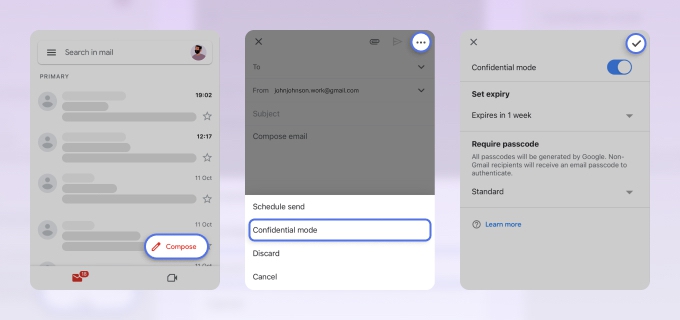
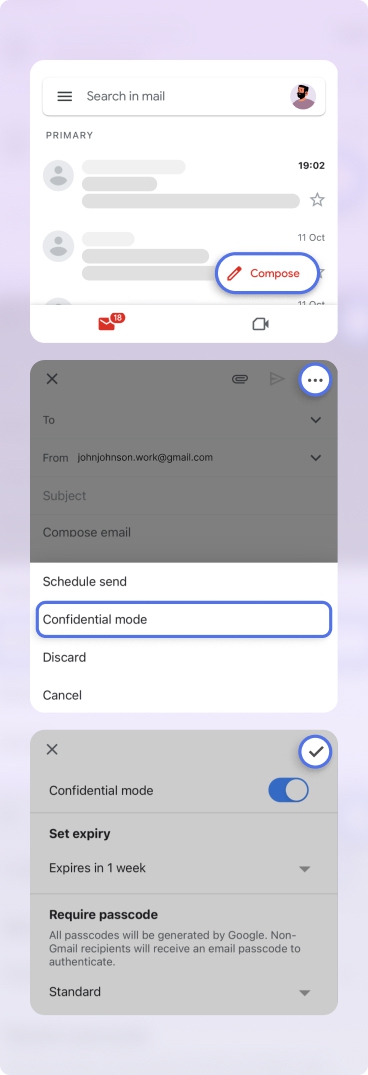
While useful, Gmail’s confidential mode isn’t a bulletproof solution (and it doesn’t claim to be). For example, your privacy can still be compromised by someone taking a screenshot of your message and sharing it that way.
Third-Party Gmail Encryption Apps
There are many third-party apps that offer an added layer of security for Gmail users. These apps typically use end-to-end encryption, making them a go-to choice for those who frequently send sensitive or confidential information via email.
Popular options to consider include ProtonMail Bridge, PreVeil, and Virtru. Each one has unique benefits for enhancing your security.
- ProtonMail Bridge allows you to use ProtonMail's strong encryption within the Gmail interface.
- PreVeil offers end-to-end encryption without requiring a complex setup.
- Tutanota offers comprehensive end-to-end encryption, covering both emails and attachments.
All three apps are built on OpenPGP, the most widely used email encryption standard in the world, so you can trust them to work just as intended.
Boost Your Gmail Security With Clean Email
Clean Email is an inbox organizer that can boost your Gmail security and privacy in two different but equally important ways. While the app isn't designed to encrypt emails, it significantly enhances your email security through a comprehensive set of features aimed at efficient inbox management.

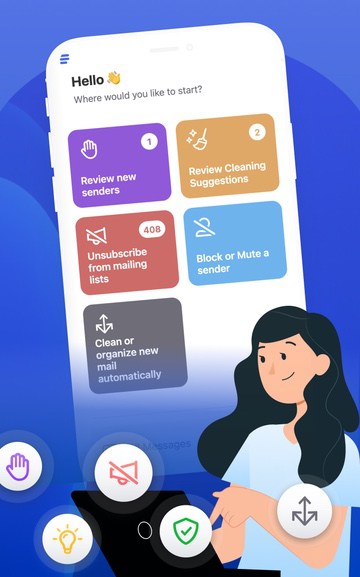
Take advantage of Clean Email’s Privacy Monitor to regularly check your Gmail address against known data breaches and security incidents. It uses data collected by the Have I Been Pwned project, one of the most comprehensive collections of database dumps and pastes containing information about billions of leaked accounts.
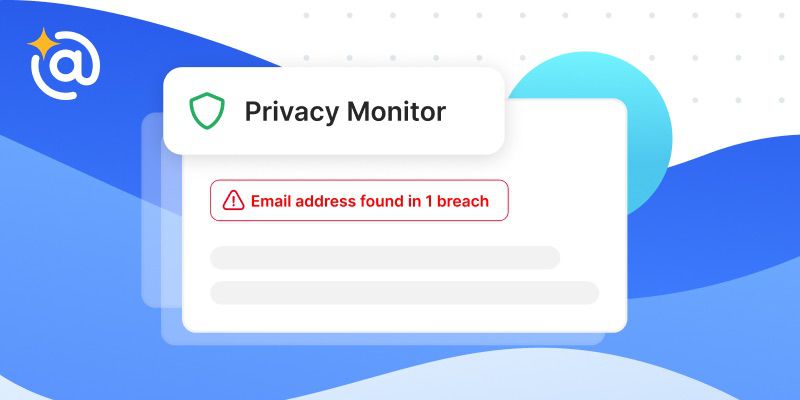

Here’s how it works:
- Go to: https://app.clean.email/
- Sign in with your Gmail account.
- Select the Privacy Monitor feature from the left pane.
- Check if your email address has been found in any breaches.

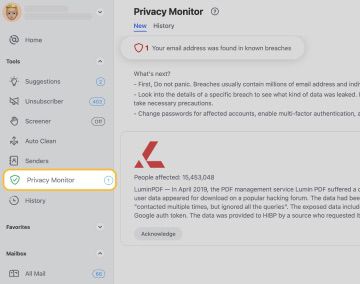
If you find your Gmail account compromised, act quickly. Assume your password is leaked and change it. If this password is used on other sites, they may also be at risk. Create new, unique passwords for each website and service that is in some way connected to the compromised account.
An additional powerful feature to enhance your email security is the Screener tool. This function segregates emails from unfamiliar senders into a distinct folder for your scrutiny. To activate it, do the following:
- Launch Clean Email and link your email account.
- Navigate to the Screener tab.
- Activate the Screener by hitting the toggle switch at the upper left corner or by pressing the Enable Screener button.
- Validate your selection by toggling the switch marked I understand, then hit Continue.
- Finalize your settings and click Enable Screener to turn it on.
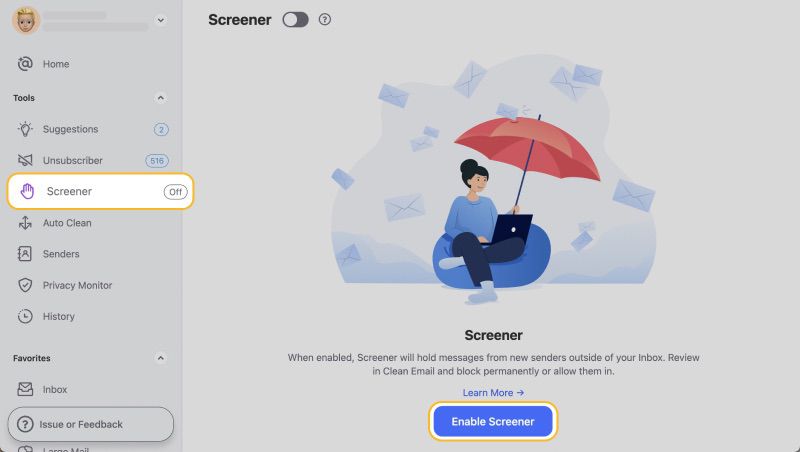
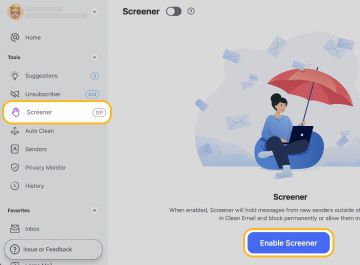

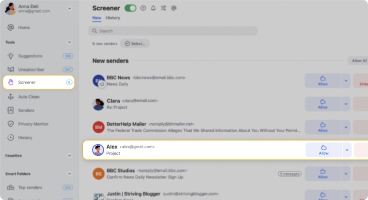
Once enabled, the Screener tool proactively enhances your email security by isolating incoming messages from new contacts. This gives you the freedom to either block or approve these senders. Approved senders' future emails will go straight to your inbox.
Another valuable feature is Smart Folders, which auto-sorts your emails, enabling you to execute bulk actions effortlessly. For instance, you can select all social media notifications in the 'Social notifications' folder and either delete or archive them in one go.
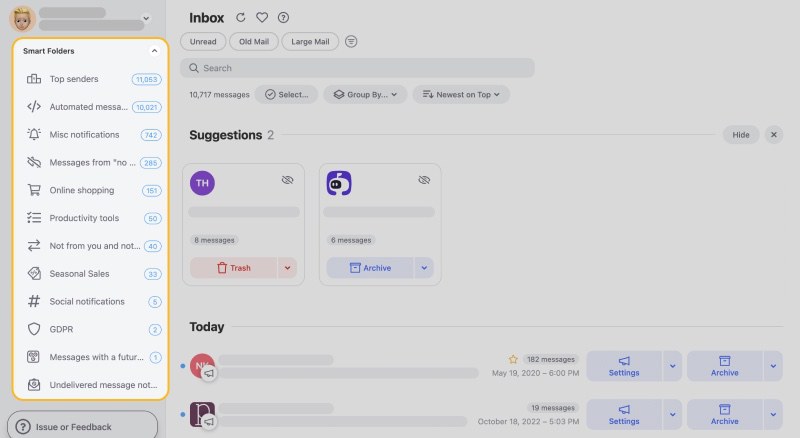
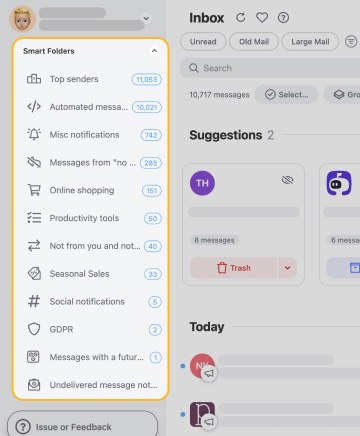
The Auto Clean feature allows you to establish rules for automatic actions on incoming emails, thereby maintaining an organized inbox.
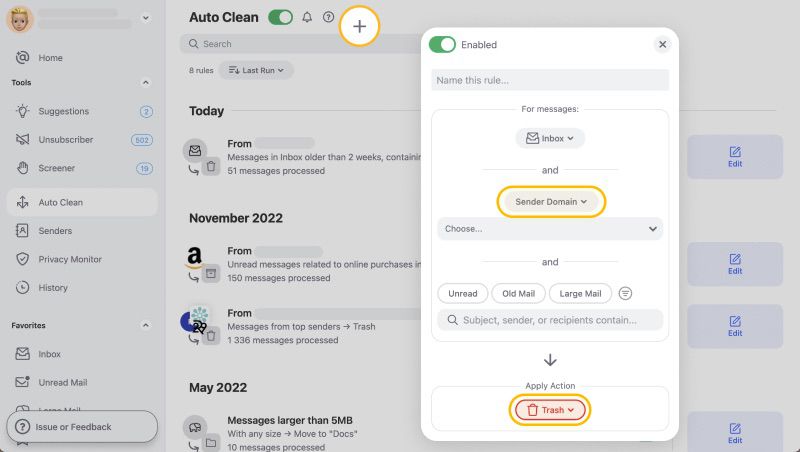

The Unsubscriber tool simplifies the task of unsubscribing from mailing lists and automatically blocks non-compliant senders on your behalf.

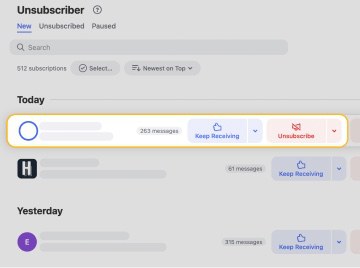
These features make Clean Email an invaluable tool for Gmail users who depend on a well-organized inbox for peak productivity. In addition, Clean Email is available on web, desktop, and mobile platforms.
Interested in learning more about email security? Check out our other guides on how to send a secure email and how to send an anonymous email and protect your privacy.
How to Encrypt an Email in Gmail - FAQ
How to send a secure email in Gmail?
To send a secure email in Gmail, you can use the built-in Confidential Mode or employ a third-party encryption app like Tutanota or PreVeil for added security.
How to send secure email in Gmail mobile?
To send encrypted email Gmail offers on mobile, tap "Compose," then select "Confidential mode" from the three-dot menu. Choose an expiration date and passcode, tap "Save," and then hit "Send" for secure transmission.
Why are some messages not encrypted?
Not all email services encrypt messages by default. Gmail fortunately does, but organizations still need to enable S/MIME manually for additional protection against threats like man-in-the-middle attacks. What’s more, S/MIME won’t work unless both parties support it.
Is Gmail confidential mode encrypted?
No, confidential mode in Gmail doesn’t turn on any additional encryption methods. Its purpose is to be a convenient way for users to improve their privacy.
How to protect email with password?
To password-protect an email in Gmail, enable "Confidential Mode." You can set a passcode and expiration date, and the recipient will need to enter the passcode to read the email.
How to encrypt Gmail attachments?
You can easily encrypt Gmail attachments using third-party apps like FlowCrypt, SendSafely, and Mailvelope, which use OpenPGP, a key-based encryption method for encrypting and decrypting data.


